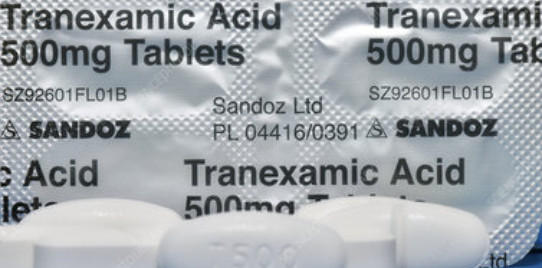
Indications and doses
- Melasma.
- Hereditary angioedema.
- Hereditary hemorrhagic telangiectasia : Intranasal tranexamic acid for epistaxis.
- Acquired angioedema type I.
Dosage
- Hereditary angioedema (For minor surgical procedures-48 hours before and after the procedure).
- In adults: 1 g four times daily.
- In children:20–40 mg/kg.
- Melasma :250 mg po twice-daily.
Baseline Monitoring
- Prothrombin time.
- Activated partial thromboplastin time.
- Other blood clotting parameters.
Follow Up Monitoring
- Regular eye examinations.
- Liver function tests in the setting of long-term administration.
Side effects
- Headache.
- Nausea, diarrhea, and abdominal pain.
- Reversible hypomenorrhea.
- Back pain ,Musculoskeletal pain.
- Deep vein thrombosis (DVT).
- Myocardial infarction.
- Pulmonary embolism.
Contraindications
- Acquired defective color vision.
- Active thromboembolic disease (eg, DVT, pulmonary embolism, or cerebral thrombosis).
- History of thrombosis or thromboembolism, including retinal vein or artery occlusion.
- Hypersensitivity to TA.
- Intrinsic risk of thrombosis or thromboembolism (eg, thrombogenic valvular disease, thrombogenic cardiac rhythm disease, or hypercoagulopathy).
- Cardiovascular disease.
- Stroke.
- Anticoagulant medications.
Drug interactions
- Combination with hormonal contraceptives >> Thromboembolic events
- Tretinoin >> Coadministration may increase procoagulant effect.
Precautions
- If any eye problems or change in vision occured , tranexamic acid must be stopped.
- Careful history should be taken , history of bleeding , history of blood clots, history of irregular menstruation.
- Tell the patient , not to take medications( contraceptive pills – drugs prevent bleeding- NSAIDs) before your consultation.
- Severe allergic reaction reported; anaphylactic shock reported with IV product.
Pregnancy & lactation
- Pregnancy Category: B; not indicated in pregnant women, cross the placenta.
- Lactation: Distributed in human breast milk at a concentration of about 1/100th of the corresponding serum concentration; should be used during lactation only if clearly needed.
Drug info
- Topical solutions of 3% teranexamic acid : 3 g teranexamic acid dissolved in 10 cc ethanol 96°+ 10 cc 1, 3-butanediol + distillated water up to 100 cc.
- Oral and topical tranexamic acid have been reported to improve the appearance of erythematotelangiectatic rosacea.
- TA injections can be administered via intradermal injections in the concentration of 4 mg/ml.
Was this helpful?
11 / 1
#Tranexamic acid